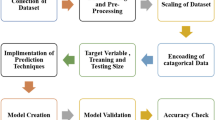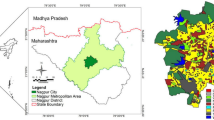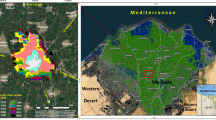Abstract
This study aimed to develop prediction models for accurately estimating construction waste generated at various stages of a project, focusing on basic civil engineering materials and to perform comparative analysis for the algorithms used for the prediction. Data from 134 construction sites was collected to create a comprehensive dataset, essential for calculating waste during dynamic construction activities. Two predictive modelling techniques, the decision tree algorithm and K-nearest neighbors (KNN) algorithm, were used to analyse the data. The study also included a comparative analysis of neural networks incorporating factors like gross floor area and material estimation. Performance evaluation of the models utilized root mean square error (RMSE) and mean absolute percent error (MAPE) methods. Results showed that waste generation occurs throughout construction projects and can significantly impact costs. A discernible waste generation pattern was identified at typical project stages. This information helps project managers anticipate waste and implement measures to minimize it, reducing costs and promoting sustainability. The developed prediction models demonstrated satisfactory accuracy, with an average RMSE value of 0.49, making them reliable for waste estimation. The decision tree and KNN models showed average accuracies of 88.32% and 88.51% respectively, highlighting their effectiveness in waste prediction. These findings provide insights for waste management and utilization, enabling stakeholders to develop strategies for sustainable construction practices. Anticipating waste facilitates the implementation of effective measures, leading to environmentally friendly projects. This research contributes valuable knowledge to waste management in the construction industry, guiding professionals and fostering a greener future.



(Source: Koyamparambath et al., 2022)
















Similar content being viewed by others
Data availability
The data that support the findings of this study are available from the author, upon reasonable request.
References
AbouRizk, S. (2010). Role of simulation in construction engineering and management. Journal of Construction Engineering and Management, 136, 1140–1153.
Abu Hammad, A., Alhaj Ali, S., Sweis, G., & Bashir, A. (2008). Prediction Model for Construction Cost and Duration in Jordan. Jordan Journal of Civil Engineering, 2(3), 250–266.
Al Mamari, A. H. S., Al Ghafri, R. S. H. H., Aravind, N., Dhandapani, R., Al Hatali, E. M. A. M., & Pandian, R. (2023). Experimental study and development of machine learning model using random forest classifier on shear strength prediction of RC beam with externally bonded GFRP composites. Asian Journal of Civil Engineering, 24, 267–286.
Ali, J., Khan, R., Ahmad, N., & Maqsood, I. (2012). Random Forests and Decision Trees. International Journal of Computer Science, 9(5), 272–278.
Aravindh, M. D., Nakkeeran, G., Krishnaraj, L., & Arivusudar, N. (2022). Evaluation and optimization of lean waste in construction industry. Asian Journal of Civil Engineering, 23, 741–752.
Azadi, S., & Karimi-Jashni, A. (2015). Verifying the performance of artificial neural network and multiple linear regression in predicting the mean seasonal municipal solid waste generation rate: A case study of Fars province. Iran. Waste Management, 48, 14–23.
Bekr, G. A. (2014). Study of the causes and magnitude of wastage of materials on construction sites in Jordan. Journal of Construction Engineering, 2014, 1–6.
Cha, G. W., Moon, H. J., Kim, Y. M., Hong, W. H., Hwang, J. H., Park, W. J., & Kim, Y. C. (2021). Development of a Prediction Model for Demolition Waste Generation Using a Random Forest Algorithm Based on Small Data Sets. International Journal of Environmental Research and Public Health, 17(19), 6997.
Chai, T., & Draxler, R. R. (2014). Root mean square error (RMSE) or mean absolute error (MAE)?—Arguments against avoiding RMSE in the literature. Geoscientific Model Development, 7, 1247–1250.
Coskuner, G., Jassim, M. S., Zontul, M., & Karateke, S. (2020). Application of artificial intelligence neural network modeling to predict the generation of domestic, commercial and construction wastes. Waste Management & Research: THe Journal for a Sustainable Circular Economy, 39(3), 499–507.
Elshaboury, N., Al-Sakkaf, A., Abdelkader, E. M., & Alfalah, G. (2022). Construction and Demolition Waste Management Research: A Science Mapping Analysis. International Journal of Environmental Research and Public Health, 19(8), 4496.
Foo, L. C., Rahman, I. A., Asmi, A., Nagapan, S., & Khalid, K. I. (2013). Classification and Quantification of Construction Waste at Housing Project Site. International Journal of Zero Waste Generation, 1(1), 1–7.
Golbaz, S., Nabizadeh, R., & Sajadi, H. S. (2019). Comparative study of predicting hospital solid waste generation using multiple linear regression and artificial intelligence. Journal of Environmental Health Science and Engineering, 17(1), 41–51.
Gulghane, A., Sharma, R. L., & Borkar, P. (2023a). Quantification analysis and prediction model for residential building construction waste using machine learning technique. Asian Journal of Civil Engineering, 24(6), 1459–1473.
Gulghane, A., Sharma, R. L., & Borkar, P. (2023b). Performance Analysis of Machine Learning Based Prediction Models for Residential Building Construction Waste. Asian Journal of Civil Engineering (in press)
Hassan, S. H., Aziz, H. A., Daud, N. M., Keria, R., Noor, S. M., Johari, I., & Shah, S. M. R. (2020). The Methods of Waste Quantification in the Construction Sites (A Review). Advances in Civil Engineering and Science Technology, AIP Conference Proceedings, 2020, 020056-1–020056-6.
Hosny, S., Elsaid, E., & Hosny, H. (2023). Prediction of construction material prices using ARIMA and multiple regression models. Asian Journal of Civil Engineering, 24, 1697–1710.
Hu, R., Chen, K., Chen, W., Wang, Q., & Luo, H. (2021). Estimation of construction waste generation based on an improved on-site measurement and SVM-based prediction model: A case of commercial buildings in China. Waste Management, 126, 791–799.
Kaveh, A., & Khalegi, A. (1998). Prediction of strength for concrete specimens using Artificial Neural Networks. 1st International Conference on Engineering Computational Technology/4th International Conference on Computational Structures Technology, 165–171.
Kaveh, A., Gholipour, Y., & Rahami, H. (2008). Optimal design of transmission towers using genetic algorithm and neural networks. International Journal of Space Structures, 1(23), 1–19.
Kaveh, A., & Rahimi Bondarabady, H. A. (2004). Wavefront reduction using graphs, neural networks and genetic algorithm. International Journal for Numerical Methods in Engineering, 60, 1803–1815.
Kaveh, A., & Servati, H. (2001). Design of double layer grids using back-propagation neural networks. Computers and Structures, 79, 1561–1568.
Kolaventi, S. S., Tezeswi, T. P., & Siva Kumar, M. V. N. (2019). An assessment of construction waste management in India: A statistical approach. Waste Management & Research, 38(4), 444–459.
Koyamparambath, A., Adibi, N., Szablewski, C., Adibi, S. A., & Sonnemann, G. (2022). Implementing Artificial Intelligence Techniques to Predict Environmental Impacts: Case of Construction Products. Sustainability, 14, 3699.
Li, Y., Zhang, X., Ding, G., & Feng, Z. (2016). Developing a quantitative construction waste estimation model for building construction projects. Resources, Conservation and Recycling, 106, 9–20.
Parsamehr, M., Perera, U. S., Dodanwala, T. C., Perera, P., Ruparathna, R. (2022). A review of construction management challenges and BIM-based solutions: Perspectives from the schedule, cost, quality, and safety management. Asian Journal of Civil Engineering, 24, 353–389.
Quiñones, R., Llatas, C., Montes, M. V., & Cortés, I. (2022). Quantification of Construction Waste in Early Design Stages Using Bim-Based Tool. Recycling, 7(5), 63.
Raju, P. M., & Kameswari, L. (2015). Construction and Demolition Waste Management—A Review. International Journal of Advanced Science and Technology, 84, 19–46.
Ram, V. G., & Kalidindi, S. N. (2017). Estimation of construction and demolition waste using waste generation rates in Chennai, India. Waste Management & Research: THe Journal for a Sustainable Circular Economy, 35(6), 610–617.
Ujong, J. A., Mbadike, E. M., & Alaneme, G. U. (2022). Prediction of cost and duration of building construction using artificial neural network. Asian Journal of Civil Engineering, 23, 1117–1139.
Wu, Z., Yu, A. T. W., Shen, L., & Liu, G. (2014). Quantifying construction and demolition waste: An analytical review. Waste Management, 34(9), 1683–1692.
Acknowledgements
The research work supported by the Lovely Professional University, Punjab, India and G H Raisoni College of Engineering, Maharashtra, India. The authors thankfully acknowledge the funding agencies for the support.
Funding
The research work supported by the Lovely Professional University, Punjab, India and G H Raisoni College of Engineering, Maharashtra, India.
Author information
Authors and Affiliations
Contributions
AG: conceptualization, methodology, validation, formal analysis, investigation, resources, data curation, writing—original draft, writing—review and editing, visualization. RLS: conceptualization, writing—review and editing, supervision. PB: writing—review and editing, supervision.
Corresponding author
Ethics declarations
Conflict of interest
The authors declare no conflict of interests.
Additional information
Publisher's Note
Springer Nature remains neutral with regard to jurisdictional claims in published maps and institutional affiliations.
Rights and permissions
Springer Nature or its licensor (e.g. a society or other partner) holds exclusive rights to this article under a publishing agreement with the author(s) or other rightsholder(s); author self-archiving of the accepted manuscript version of this article is solely governed by the terms of such publishing agreement and applicable law.
About this article
Cite this article
Gulghane, A., Sharma, R.L. & Borkar, P. A formal evaluation of KNN and decision tree algorithms for waste generation prediction in residential projects: a comparative approach. Asian J Civ Eng 25, 265–280 (2024). https://doi.org/10.1007/s42107-023-00772-5
Received:
Accepted:
Published:
Issue Date:
DOI: https://doi.org/10.1007/s42107-023-00772-5






